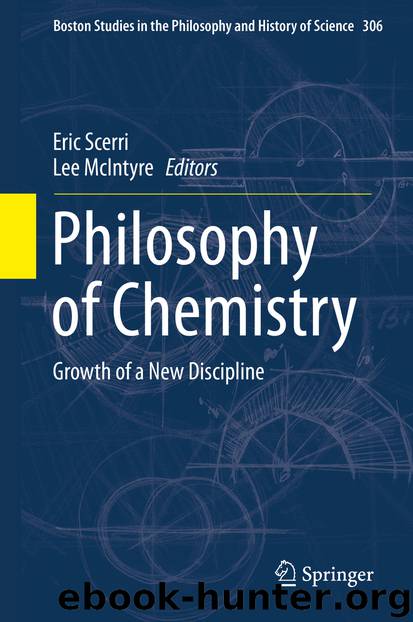Philosophy of Chemistry by Eric Scerri & Lee McIntyre

Author:Eric Scerri & Lee McIntyre
Language: eng
Format: epub
Publisher: Springer Netherlands, Dordrecht
8.5 Affordances
‘Affordance’ is the word coined by J. J. Gibson (1979) to present his theory of perception. This was a radical departure from the sense data theories of such as Russell and the constructionism of such as Kant. In those theories what we see is said to be the product of a cognitive process by which elementary sensations, such as coloured patches in the visual field, are synthetized into objects and processes. Gibson argued that certain invariant structural properties of things afforded perceptions of those things to people and animals as they explored the flux of electromagnetic and sonic energy within they lived. Not only that, but Gibson pointed out that we can also discern perceptually what something can be used for. Most people can see that a knife can be used for cutting – in this terminology we say a knife affords cutting. But only in a human context does a certain piece of steel have that attribute. We can also say that a floor affords walking to people, while a lake does not, though it did to Jesus. An affordance is relative to context, in particular to the specific interaction between some human beings and the material world.
From the point of view of the grammar of a chemical discourse an affordance is a disposition or capacity as ascribed to a certain material being to yield an observable effect when acted upon in a certain manner. It may be an observable property, say ‘tensile strength’, or an entity, say a gas as the product of a chemical reaction, that is when certain substances are acted on in a certain way. In mereological chemistry we conclude that the advent of tensile strength is due to a new arrangement of the atoms in the molecules of at least one of the reagents, while the advent of the gas is the release of a constituent of one of the original substances. We imbibe mereological thinking with the very first chemical experiment many of us perform – obtaining a sample of hydrogen from the reaction of metallic zinc with a dilute solution of hydrochloric acid.
Written out in full the attribution of an affordance has the form of a conditional – ‘if a certain procedure is carried out on a certain substance then it will display a certain attribute or yield a certain substance’. So adding carbon to iron increases the tensile strength of a rod, that is a property it displays only when put into tension in some machine. Adding zinc to a solution of hydrochloric acid yields a gas that after several decades of eighteenth and nineteenth century debate we now label ‘hydrogen’. Hydrochloric acid affords hydrogen only in certain particular circumstances.
Download
This site does not store any files on its server. We only index and link to content provided by other sites. Please contact the content providers to delete copyright contents if any and email us, we'll remove relevant links or contents immediately.
Enlightenment Now: The Case for Reason, Science, Humanism, and Progress by Steven Pinker(7228)
A Journey Through Charms and Defence Against the Dark Arts (Harry Potter: A Journey Through…) by Pottermore Publishing(4781)
The Immortal Life of Henrietta Lacks by Rebecca Skloot(4525)
A Journey Through Divination and Astronomy by Publishing Pottermore(4344)
Elon Musk by Ashlee Vance(4028)
Origin Story: A Big History of Everything by David Christian(3648)
COSMOS by Carl Sagan(3554)
Alchemy and Alchemists by C. J. S. Thompson(3449)
Bad Pharma by Ben Goldacre(3355)
Enlightenment Now by Steven Pinker(3335)
Shadow of Night by Deborah Harkness(3302)
Inferior by Angela Saini(3276)
A Mind For Numbers: How to Excel at Math and Science (Even If You Flunked Algebra) by Barbara Oakley(3217)
Origin Story by David Christian(3147)
The Code Book by Simon Singh(3074)
Signature in the Cell: DNA and the Evidence for Intelligent Design by Stephen C. Meyer(3071)
The Elements by Theodore Gray(2998)
A Brief History of Time by Stephen Hawking(2960)
A Journey Through Potions and Herbology (A Journey Through…) by Pottermore Publishing(2826)
